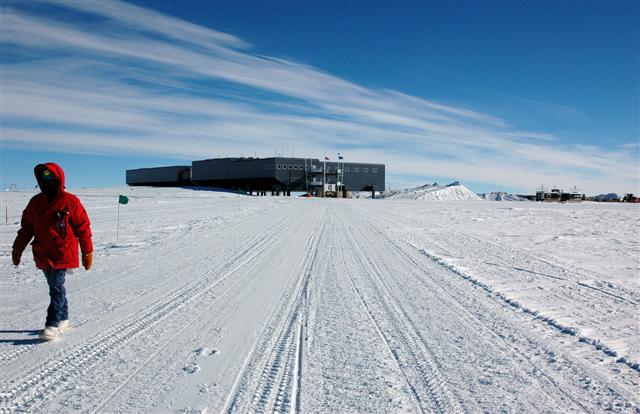|
In the pitsScientists dig through South Pole snow for climate cluesPosted March 1, 2013
Snow retrieved from a pit dug at the South Pole Particles from the upper atmosphere trapped in a deep pile of Antarctic snow hold clear chemical traces of global meteorological events, scientists reported in the early online edition of the Proceedings of the National Academy of Sciences published the week of Feb. 25. Anomalies in oxygen found in sulfate particles coincide with several episodes of the world-wide disruption of weather known as El Niño “Our ability to link reliable chemical signatures to well-known events will make it possible to reconstruct similar short-term fluctuations in atmospheric conditions from the paleohistory preserved in polar ice,” said Mark Thiemens 
Photo Credit: Peter Rejcek/Antarctic Photo Library
South Pole Station where the field research was supported.
Thiemens, graduate student Justin McCabe and colleague Joel Savarino of Laboratoire de Glaciologie et Géophysique de l'Environnment in Grenoble, France, excavated a pit six meters deep in the snow near the South Pole, with shovels. “At an elevation of 10,000 feet and 55 degrees below zero, this was quite a task,” Thiemens said in a UCSD press release Atmospheric sulfates form when sulfur dioxide — one sulfur and two oxygen molecules — mixes with air and gains two more oxygen molecules. This can happen a number of different ways, some of which favor the addition of variant forms of oxygen, or isotopes, with an extra neutron or two, previous work by Thiemens’ group has shown. Unlike polar ice, which compresses months of precipitation so tightly that resolution is measured in years, relatively fluffy snow allowed the team to resolve this record of atmospheric chemistry on a much finer scale. “That was key,” said Robina Shaheen, a project scientist in Thiemen’s research group who led the chemical analysis and was lead author on the paper. “This record was every six months. That high resolution made it clear we can trace a seasonal event such as ENSO.” El Niño is an abnormal warming of surface ocean waters in the eastern tropical Pacific. The Southern Oscillation is the seesaw pattern of reversing surface air pressure between the eastern and western tropical Pacific. When the surface pressure is high in the eastern tropical Pacific, it is low in the western tropical Pacific, and vice-versa. Because the ocean warming and pressure reversals are, for the most part, simultaneous, scientists call this phenomenon the El Nino/Southern Oscillation ENSO is often blamed for extreme weather events around the world, from droughts to floods. The warmed air above the sea surface lifts sulfur dioxide high into the stratosphere, a layer of atmosphere above the troposphere, where it’s oxidized by ozone, which imparts a distinctly different, anomalous pattern of oxygen variants to the resulting sulfate particles. In the Antarctic snow samples, the chemists found traces of these oxygen anomalies in sulfates trapped within layers of snow that fell during strong El Niño seasons. Volcanoes too can shoot sulfur compounds high into the atmosphere where they react with ozone to produce sulfates with oxygen anomalies. Three large volcanoes, El Chichón, Pinatubo and Cerro Hudson, erupted over the course of this time sample, which stretched from 1980 to 2002 and encompassed three ENSO events as well. NSF funded research in this story: Mark Thiemens and Joel Savarino, University of California, San Diego, Award No. 0125761 |



For USAP Participants |
For The Public |
For Researchers and EducatorsContact UsU.S. National Science FoundationOffice of Polar Programs Geosciences Directorate 2415 Eisenhower Avenue, Suite W7100 Alexandria, VA 22314 Sign up for the NSF Office of Polar Programs newsletter and events. Feedback Form |


